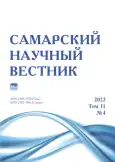Microcrystallization method use for assessing the content of secondary metabolites of lichens
- Authors: Kasyanova A.P.1, Korchikov E.S.1
-
Affiliations:
- Samara National Research University
- Issue: Vol 11, No 4 (2022)
- Pages: 47-51
- Section: Biological Sciences
- URL: https://journals.rcsi.science/2309-4370/article/view/133216
- DOI: https://doi.org/10.55355/snv2022114106
- ID: 133216
Cite item
Full Text
Abstract
The paper presents photographs of crystals of fumarprotocetraric, evernic, usninic, solorinic, olivetoric, perlatolinic, physodalic, salazinic, tamnolic acids and atranorin obtained from their acetone extracts of lichens. The shape of the crystals is specific to each substance, and their number, size and degree of aggregation depend on the concentration in the solution. Stellate crystals have atranorine, salazinic and evernic acids, with atranorine having the largest and salacic acid having the smallest; rod–shaped branched crystals form solorinic and fumarprotocetraric acids, wider in the first, but longer in the second; the oval shape of crystals in the larger tamnolic and small and narrow perlatolinic acid; usnic, physodalic and olivetoric acids form unique crystal forms – prismatic, needle branched and pinnate, respectively. It is possible to observe crystals of secondary metabolites of lichens with a conventional light microscope under a ×40 lens without immersion oil. For the subsequent comparative assessment of the amount of substances, it is necessary to standardize the suspension of the studied lichen thallus, use a strictly fixed volume of acetone, view at least four sides of the dried drop on the slide and identify their total number in points, noting the presence, degree of branching and aggregation of crystals into conglomerates.
Full Text
##article.viewOnOriginalSite##About the authors
Anastasia Pavlovna Kasyanova
Samara National Research University
Email: anastasiakasyanova22@mail.ru
student of Biological Faculty
Russian Federation, SamaraEvgeniy Sergeevich Korchikov
Samara National Research University
Author for correspondence.
Email: evkor@inbox.ru
candidate of biological sciences, associate professor of Ecology, Botany and Nature Protection Department
Russian Federation, SamaraReferences
- Anshakova V.V. Mechanochemical technology for producing of biocomplexes based on lichen material // Russian Journal of Biopharmaceuticals. 2011. Vol. 3, № 5. P. 32–41.
- Флора лишайников России: биология, экология, разнообразие, распространение и методы изучения лишайников / под ред. М.П. Андреева, Д.Е. Гимельбранта. М.; СПб.: Товарищество науч. изд. КМК, 2014. 400 с.
- Муравьёва Д.А., Самылина И.А., Яковлев Г.П. Фармакогнозия: учебник. 4-е изд., перераб. и доп. М.: Медицина, 2002. 656 с.
- Brodo I.M., Sharnoff S.D., Sharnoff S. Lichens of North America. New Haven; London: Yale University Press, 2001. 795 p.
- Прокопьев И.А., Порядина Л.Н., Филиппова Г.В., Шеин А.А. Содержание вторичных метаболитов в лишайниках сосновых лесов Центральной Якутии // Химия растительного сырья. 2016. № 3. С. 73–78.
- Прокопьев И.А., Шеин А.А., Филиппова Г.В., Филиппов Э.В., Шашурин М.М., Гладкина Н.П. Годовая динамика содержания усниновой кислоты в талломах лишайников родов Cladonia и Flavocetraria, произрастающих в Центральной Якутии // Химия растительного сырья. 2015. № 4. С. 45–49. doi: 10.14258/jcprm.201504767.
- Гладкина Н.П., Прокопьев И.А., Шеин А.А., Филиппова Г.В. Сезонные изменения содержания усниновой кислоты в талломах некоторых лишайников, произрастающих в условиях Центральной Якутии // Новые материалы и технологии в условиях Арктики: мат-лы междунар. симпозиума. Якутск: Центр научного знания «Логос», 2014. С. 85–89.
- Слонов Т.Л., Слонов Л.Х. Лишайниковые кислоты и фитомасса избранных видов лишайников // Известия высших учебных заведений. Северо-Кавказский регион. Серия: Естественные науки. 2010. № 5. С. 79–82.
- Protocols in lichenology: culturing, biochemistry, ecophysiology and use in biomonitoring / ed. by I.C. Kranner, R.P. Beckett, A.K. Varma. Heidelberg: Springer, 2002. 580 p. doi: 10.1007/978-3-642-56359-1.
- Lichen biology. Second edition / ed. by T.H. Nash. New York: Cambridge University Press, 2008. 502 p.
- Orange А., James P.W., White F.J. Microchemical methods for the identification lichens. London: British Lichen Society, 2010. 104 p.
- Hale M.E. The biology of lichens. London: Edward Arnold, 1974. 181 p.
- Atranorin [Internet] // PubChem. https://pubchem.ncbi.nlm.nih.gov/compound/68066.
- Olivetoric acid [Internet] // PubChem. https://pubchem.ncbi.nlm.nih.gov/compound/591238.
- Salazinic acid [Internet] // PubChem. https://pubchem.ncbi.nlm.nih.gov/compound/5320418.
- Храмченкова О.М. Лишайники Hypogymnia physodes, Evernia prunastri, Cladonia arbuscula и Xanthoria parietina как источники веществ с антибактериальной активностью // Бюллетень Брянского отделения Русского ботанического общества. 2017. № 1 (9). С. 50–58.
- Anthraquinone, 2-hexanoyl-1,3,8-trihydroxy-6-methoxy- [Internet] // PubChem. https://pubchem.ncbi.nlm.nih.gov/compound/99653.
- Thamnolic acid [Internet] // PubChem. https://pubchem.ncbi.nlm.nih.gov/compound/4316933.
- Usnic acid [Internet] // PubChem. https://pubchem.ncbi.nlm.nih.gov/compound/5646.
- Usnic acid [Internet] // Environmental Protection Agency. https://comptox.epa.gov/dashboard/dtxsid0040123.
- Physodalic acid [Internet] // PubChem. https://pubchem.ncbi.nlm.nih.gov/compound/5489369.
- Fumarprotocetraric acid [Internet] // PubChem. https://pubchem.ncbi.nlm.nih.gov/compound/5317419.
- Evernic acid [Internet] // PubChem. https://pubchem.ncbi.nlm.nih.gov/compound/10829.
- Perlatolinic acid [Internet] // PubChem. https://pubchem.ncbi.nlm.nih.gov/compound/174857.
- Прокопьев И.А., Шаварда А.Л., Филиппова Г.В., Шеин А.А. Применение высокоэффективной жидкостной хроматографии для определения содержания вторичных метаболитов лишайников // Журнал аналитической химии. 2017. Т. 72, № 11. С. 1025–1031. doi: 10.7868/s004445021711007x.
Supplementary files

















